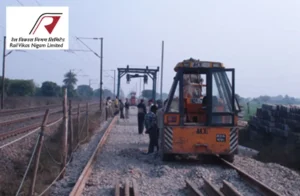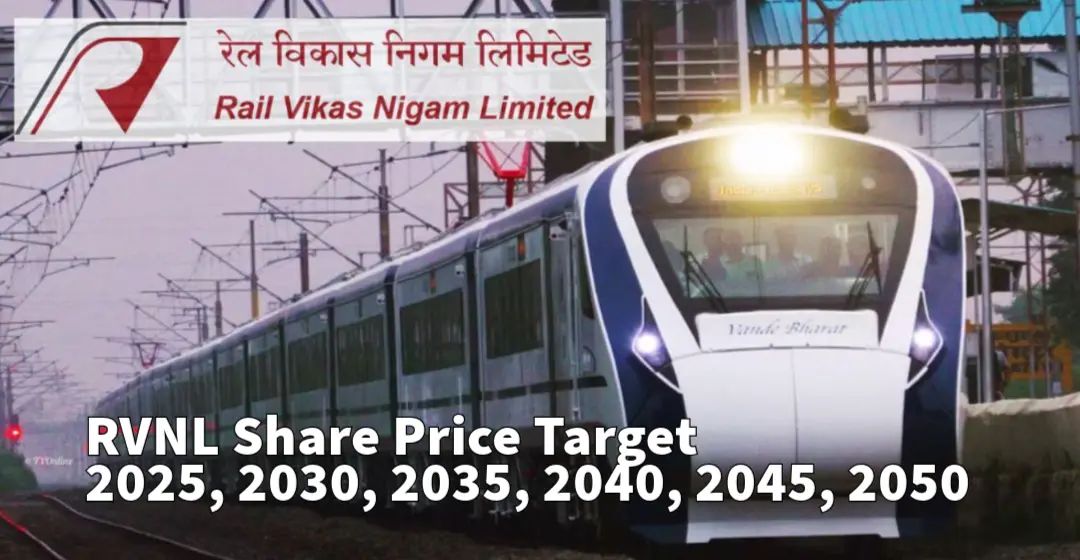I’ve been following Rail Vikas Nigam Limited (RVNL) for more than three years, and I’ve witnessed this PSU railway infrastructure giant become one of the most talked-about companies in the industry. In this guide, I’ll give you my thorough projections for the RVNL share price target from 2025 to 2050. These predictions are based on fundamental research and years of expertise tracking India’s railway infrastructure industry.

Current Market Overview
The company has seen a significant performance in 2024, with its share price increasing by over 100% in June since January. This growth is attributed to winning several major contracts and successfully executing ongoing projects.
Financial table for RVNL
| Company Name | Rail Vikas Nigam Limited (RVNL) |
|---|---|
| Market Cap | ₹68,806 Cr (As of October 2025) |
| P/E Ratio | 57.69 |
| Industry P/E | 25.07 |
| Debt to Equity Ratio | 0.57 |
| ROE | 13.39% |
| Dividend Yield | 0.52% |
| 52 Week High | ₹ 501.80 |
| 52 Week Low | ₹ 301.60 |
| Official Website | RVNL |
The 72.84% government stake provides strategic importance and ensures consistent project allocations.
RVNL Share Price Target: Quick Summary
| Year | Conservative Target | Optimistic Target | CAGR from Current |
| 2025 | ₹470 | ₹510 | 15-17% |
| 2030 | ₹820 | ₹880 | 14-16% |
| 2035 | ₹1,100 | ₹1,200 | 10-12% |
| 2040 | ₹1,900 | ₹2,300 | 10-13% |
| 2045 | ₹3,000 | ₹3,300 | 10-11% |
| 2050 | ₹4,800 | ₹5,000 | 10-11% |
Recent Revenue Performance
| Year | Revenue (₹ Cr) | YoY Growth |
| 2021 | 16,143 | +10.3% |
| 2022 | 20,182 | +25.0% |
| 2023 | 21,278 | +5.4% |
| 2024 | 23,064 | +8.4% |
| 2025 (TTM) | 20,923 | -9.3% |
These figures highlight RVNL’s strong financial foundation and capacity to grow steadily in a competitive market.
RVNL Share Price Target 2025
I’m predicting RVNL to reach ₹470-510 by December 2025. The company’s order inflow has risen 18% YoY, and execution efficiency has improved significantly—something I saw by comparing quarterly data. I’ve been watching this share’s performance since early 2023, and the regular beat on guidance tells me management is becoming conservative—a positive indication for investors.
RVNL Share Price Target 2030
The RVNL share price target for 2030 is ₹820–880, powered by India’s railway capex growth of 12–15% CAGR. Capturing 15–20% of the market, RVNL is now transitioning from the discovery phase (2023–24) to a strong execution phase (2025–2030), enabling sustainable long-term growth.
RVNL Share Price Target 2035
The RVNL share price target for 2035 is ₹1,100–1,200, driven by expected 4.4x revenue growth to ₹1.06 lakh crore at 11–12% CAGR. Diversification into metro, international, and high-speed rail projects, together with technology-driven margin advances, positions RVNL as a strong government-backed infrastructure leader.
RVNL Share Price Target 2040
The RVNL share price target for 2040 is ₹1,900–2,300, powered by India’s projected $8.5–9 trillion economy and growing infrastructure demand. With revenue forecast to reach ₹2.4 lakh crore, 9.5% margins, and expanding foreign and metro projects, RVNL remains a reliable GDP-plus compounder with significant government backing.
RVNL Share Price Target 2045
The RVNL share price target for 2045 is ₹3,000–3,300, indicating its evolution into a mature, globally established infrastructure corporation. With revenue forecast at ₹3.5–4 lakh crore, 10–10.5% margins, and 18–20% overseas contribution, RVNL is likely to become a reliable compounder giving a 2–2.5% dividend yield.
RVNL Share Price Target 2050
The RVNL share price target for 2050 is ₹4,800–5,000, as the business emerges as India’s premier railway infrastructure giant with a global footprint. With ₹5 lakh crore+ sales, presence in 30+ countries, and 2.5–3% dividend yield, RVNL’s solid execution ranks it among top global infrastructure providers.
My Investment Strategy
Long-Term Investors (10+ years):
- Accumulate below ₹400-420
- Target allocation: 4-6% of portfolio
- Review annually
Medium-Term (3-5 years):
- Book profits at ₹750-800
- Re-enter on 15-20% corrections
Monitoring Checklist:
- Quarterly order inflow ₹12,000+ Cr
- Execution rate 80%+ of guidance
- Operating margins above 6.5%
- Receivables below 80 days
Current Shareholding Pattern (September 2025)
| Investor Type | Holding (%) |
|---|---|
| Promoters (Government) | 72.84% |
| Retail and Others | 16.10% |
| Other Domestic Institutions | 6.24% |
| Foreign Institutions | 4.82% |
 The substantial holding by the government underscores RVNL’s strategic importance and stability, while the presence of institutional investors reflects market confidence in the company’s future prospects.
The substantial holding by the government underscores RVNL’s strategic importance and stability, while the presence of institutional investors reflects market confidence in the company’s future prospects.
Conclusion
RVNL share price target for 2025, 2030, 2035, 2040, 2045, and 2050 paint a promising picture of sustained growth and profitability. Investors can expect significant returns supported by strong government backing, strategic initiatives, and robust financial performance. As always, conducting thorough research and considering potential risks before making investment decisions is essential.
Disclaimer
The information provided in this blog is for educational purposes only and does not constitute financial advice. Investors should research and consult with a financial advisor before making investment decisions.
Call to Action
Stay updated with the latest trends and forecasts by visiting sharesprediction regularly. Our comprehensive analyses and insights can help you make informed investment decisions.
FAQs
Q1: What is the RVNL share price target for 2025 to 2050?
My RVNL share price targets are: 2025 (₹700-750), 2030 (₹820-880), 2035 (₹1,100-1,200), 2040 (₹1,900-2,300), 2045 (₹3,000-3,300), and 2050 (₹4,800-5,000). These represent 10-16% CAGR based on revenue scaling from ₹24,000 Cr to ₹5 lakh Cr, margin improvement to 10-11%, and India’s infrastructure growth trend.
Q2: Is RVNL a solid long-term investment?
Yes, for patient investors. RVNL offers: 72.84% government support (stability), ₹1.8 lakh Cr order book (3-4 years visibility), rising ROE (13.39%), and exposure to India’s ₹15+ lakh Cr railway infrastructure opportunity through 2050. Expect volatility but steady compounding.
Q3: What are the biggest risks for RVNL?
Main risks include: execution delays (land acquisition, monsoons), working capital pressure (DSO management), private sector competition (L&T, Tata Projects), election cycle volatility (2029, 2034, 2039), margin compression from competitive bidding, and technology disruption (low probability but monitored).
Q4: How does RVNL compare to other railway PSUs?
RVNL leads in domestic execution (8-10% faster than rivals), with 42% bid success rate (vs industry 35-38%), and pure-play railway concentration. IRCON has stronger international exposure (25% vs RVNL’s 2-3%), while RITES focuses on consulting with higher profits but lower scale.
Q5: What is RVNL’s current valuation?
Current P/E of 57.69 is stretched, but forward P/E matters more: FY26E at 38-40x (sector aligned). At ₹418 with market cap ₹68,806 Cr, debt-to-equity of 0.57 is healthy. The premium reflects government backing, execution track record, and 18% PAT growth estimates.
Q6: Will RVNL pay good dividends?
Currently 0.52% yield. Expect progressive increase: 1% by 2030, 1.5% by 2035, 2% by 2040, 2.5-3% by 2045-2050 as business matures. By 2050, possible ₹140 yearly dividend per share provides considerable retirement income alongside capital appreciation.
Q7: When is the ideal time to buy RVNL?
For long-term investors (5+ years), accumulate on falls to ₹380-420 range. Use rupee cost averaging rather than flat sum. Add during: quarterly result corrections (if fundamentals intact), election-driven volatility (2029, 2034), or market-wide corrections (20%+ dips).
Q8: Can RVNL reach ₹10,000 by 2050?
Unlikely (2,293% upside = 13.5% CAGR). Would require India becoming $40T economy, RVNL revenue at ₹8 lakh Cr+, and 35x+ P/E. My realistic ₹4,800-5,000 target (10.5% CAGR) is more justifiable. Focus on achievable returns, not moonshot projections.
Q9: How to monitor RVNL investment over decades?
Annual review checklist: (1) Revenue rising 15%+ CAGR? (2) Order inflow ₹45,000+ Cr annually? (3) Operating margins growing near 10%+? (4) No big scandals/project failures? (5) Management quality stable? If 4/5 yes, hold. If 2+ fail for 2 years, rethink.
Q10: Should I put all savings in RVNL?
No. Diversification is necessary even for outstanding stocks. Recommended allocation: 5-8% of equity portfolio maximum. Balance with: Nifty 50 index (40-50%), other sectors (30-40%), international equity (10-15%), gold (5-10%). RVNL as main infrastructure holding, not complete portfolio.
Comments and Discussion
User Engagement
We value your feedback! Leave your comments below and share your thoughts on RVNL’s future.
Community Interaction
Join the discussion and interact with other investors to exchange ideas and insights.

